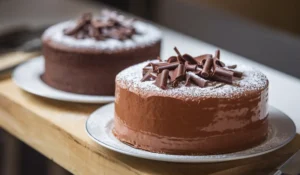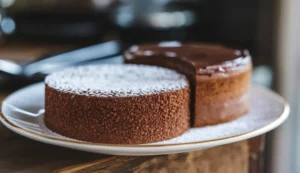Chocolate cake is a universally adored dessert, but have you ever wondered why there are so many variations? Two popular types that often get confused with each other are Devil’s Food Cake and the classic chocolate cake. Although they share some similarities—both are rich, moist, and chocolatey—they have distinct characteristics that set them apart.
Introduction to Chocolate Cake
Chocolate cake is a versatile and beloved treat that has been a staple in many cultures for centuries. Its origins date back to the 18th century when chocolate was first used as an ingredient in baked goods. Over time, chocolate cake has evolved into various forms, from the dense and rich chocolate torte to the light and fluffy chocolate sponge cake.
Today, chocolate cake comes in an array of styles, each offering a unique texture and flavor profile. Whether it’s a simple one-layer cake or an elaborate multi-tiered masterpiece, the primary focus is on the rich taste of chocolate.
The Origins of Devil’s Food Cake
Devil’s Food Cake, on the other hand, has a somewhat more mysterious and dramatic origin. This indulgent dessert first appeared in American cookbooks around the early 20th century. Its name alone—“Devil’s Food”—suggests something sinful, tempting, and rich. While some believe the name was chosen to contrast with the angelic lightness of Angel Food Cake, others think it simply represents the cake’s deep, dark chocolate flavor, which was considered more decadent and indulgent than traditional cake.
Devil’s Food Cake became increasingly popular due to its moist texture and intense cocoa flavor, distinguishing it from other cakes of its time. The cake’s association with the devil was not unique to desserts—many dishes from that era featured playful names that invoked ideas of indulgence and sin, reflecting the cake’s rich and tempting nature.
Ingredient Differences Between Devil’s Food Cake and Chocolate Cake
Although both cakes contain key ingredients such as flour, sugar, eggs, and cocoa powder, there are some subtle but important differences in the ingredients used, which contribute to their unique characteristics.
Cocoa Powder vs. Melted Chocolate
One of the primary differences lies in the type of chocolate used. Traditional chocolate cakes often rely on melted chocolate for their rich flavor. Melted chocolate adds a certain creaminess and smooth texture to the cake, creating a deep and rich chocolate taste that is often more subdued compared to Devil’s Food Cake.
In contrast, Devil’s Food Cake typically uses cocoa powder instead of melted chocolate. Cocoa powder gives the cake a more intense, robust chocolate flavor because it lacks the added fats and sugar found in processed chocolate bars. This difference in chocolate base contributes to the bolder taste that many people associate with Devil’s Food Cake.
The Role of Baking Soda and Baking Powder
Another significant difference is the leavening agents used in each cake. Chocolate cakes often rely on baking powder to help the batter rise, resulting in a lighter and fluffier texture. Devil’s Food Cake, however, uses baking soda, which reacts with the acidic components of the recipe (such as cocoa powder and buttermilk) to create a more dramatic rise. This reaction also deepens the color of the cake, giving it its signature dark appearance.
The use of baking soda versus baking powder not only affects the cake’s appearance but also its texture. Devil’s Food Cake tends to be lighter and more aerated, despite its rich flavor, whereas traditional chocolate cake may have a denser, more velvety crumb.
Fats: Butter vs. Oil

In terms of fat content, akes traditionally use butter, which contributes to a denser and more luxurious texture. Butter has a distinct flavor and richness that many bakers and chocolate lovers appreciate. It also creates a more solid crumb, which is ideal for stacking cake layers or frosting with intricate designs.
Devil’s Food Cake, on the other hand, often uses vegetable oil instead of butter. Oil helps to retain moisture and creates a lighter texture, resulting in a cake that feels less heavy but remains incredibly moist. The use of oil also makes Devil’s Food Cake more forgiving when it comes to mixing—overmixing the batter with oil won’t lead to the same toughness that overmixing with butter might cause.
The Science Behind the Differences
Understanding the science behind these ingredients can help you appreciate why Devil’s Food Cake and chocolate cake taste and feel different from one another. For instance, the acidity of cocoa powder used in Devil’s Food Cake activates the baking soda, causing it to release carbon dioxide and create air bubbles. This is what gives the cake its light, fluffy texture.
In contrast, the fats and dairy used in a traditional chocolate cake affect the structure and moisture content. The inclusion of melted chocolate, for instance, adds both liquid and solid fats, which contribute to a denser texture. Butter, which solidifies when cooled, also plays a key role in the firmness and overall crumb structure of a traditional chocolate cake.
Texture and Flavor Profile
Another point of distinction between Devil’s Food Cake and cake is their texture and flavor profiles. Although both cakes are beloved for their chocolate flavor, the experience of eating them is quite different.
Devil’s Food Cake Texture
Devil’s Food Cake is known for its light, airy texture, which contrasts with its intense chocolate flavor. Thanks to the use of baking soda, oil, and cocoa powder, this cake feels almost ethereal, despite being rich in flavor. It’s the kind of cake that melts in your mouth, leaving behind a lingering cocoa taste.
Chocolate Cake Texture
Chocolate cake, in contrast, tends to be denser and more filling. The butter and melted chocolate create a rich, velvety texture, making each bite indulgent and satisfying. It’s the kind of cake that feels substantial and comforting, with a creamy mouthfeel due to the butterfat and chocolate.
Frosting and Decoration Differences
While the cake itself is important, the frosting and decoration can significantly impact the overall experience of a Devil’s Food Cake versus a traditional chocolate cake. Both cakes are commonly frosted with chocolate-based icings, but the types of frosting often differ in terms of richness and sweetness.
Devil’s Food Cake Frosting
Devil’s Food Cake often pairs well with lighter, fluffier frostings like a whipped ganache or chocolate buttercream. Because the cake itself is already rich in chocolate flavor, the frosting can be slightly less intense and more focused on complementing the airy texture of the cake. Some bakers even opt for a marshmallow frosting, which adds a contrasting sweetness and lightness to the cake’s deep cocoa flavor.
Chocolate Cake Frosting
Chocolate cakes, on the other hand, frequently use heavier frostings such as fudge icing or a thicker ganache. These frostings add to the richness and decadence of the cake, creating a dessert that is truly indulgent. Cream cheese frosting is also a popular choice for balancing out the sweetness of a traditional chocolate cake with a slight tanginess.
Cultural and Historical Significance
Beyond their ingredients and textures, Devil’s Food Cake and chocolate cake have different cultural and historical backgrounds that have influenced their popularity.
Devil’s Food Cake in American Culture
Devil’s Food Cake has long been associated with indulgence and decadence in American culture. Its name alone has an allure that suggests something forbidden or luxurious. During the 20th century, Devil’s Food Cake became a popular choice for special occasions and celebrations, symbolizing the ultimate chocolate indulgence. In some regions, it became a classic birthday or holiday dessert.
Chocolate Cake in Global Culture
Chocolate cake, in its various forms, is a global dessert staple. Its history stretches back to the 18th century when chocolate became more widely available in Europe. As chocolate’s popularity grew, so did the variety of chocolate cakes, with different regions creating their own versions. From the dense flourless cakes of France to the layered sponge cakes of Central Europe, chocolate cake has evolved into a symbol of comfort, celebration, and festivity worldwide.
How to Make the Perfect Devil’s Food Cake
Now that you understand the differences between Devil’s Food Cake and chocolate cake, let’s dive into the steps to make the perfect Devil’s Food Cake at home. Here’s a recipe that emphasizes its unique characteristics:
Ingredients:
- 2 cups all-purpose flour
- ¾ cup unsweetened cocoa powder
- 2 teaspoons baking soda
- 1 teaspoon baking powder
- ½ teaspoon salt
- 2 cups granulated sugar
- 1 cup vegetable oil
- 1 cup buttermilk
- 3 large eggs
- 1 teaspoon vanilla extract
- 1 cup hot water (or coffee for an even richer flavor)
Instructions:
- Preheat the Oven: Set your oven to 350°F (175°C) and grease two 9-inch round cake pans. Line the bottoms with parchment paper to ensure easy release.
- Combine Dry Ingredients: In a large bowl, sift together the flour, cocoa powder, baking soda, baking powder, and salt.
- Mix Wet Ingredients: In another bowl, whisk together the sugar, oil, buttermilk, eggs, and vanilla extract until smooth.
- Combine: Gradually add the dry ingredients to the wet ingredients, mixing until just combined. Slowly add the hot water (or coffee) to the batter, mixing on low speed until incorporated. The batter will be thin, but this is key to the cake’s moist texture.
- Bake: Divide the batter evenly between the prepared pans and bake for 30-35 minutes, or until a toothpick inserted into the center comes out clean. Let the cakes cool in the pans for 10 minutes before transferring them to a wire rack to cool completely.
- Frost: Once the cakes are completely cooled, frost them with your choice of frosting, such as a light whipped ganache or buttercream.
Frequently Asked Questions (FAQs)

What is the difference in taste between Devil’s Food Cake and chocolate cake?
Devil’s Food Cake has a more intense chocolate flavor, thanks to the use of cocoa powder, while traditional chocolate cake often has a milder, sweeter taste due to the use of melted chocolate. The addition of coffee in some Devil’s Food Cake recipes can also enhance the depth of chocolate flavor.
Can I substitute cocoa powder for melted chocolate in a recipe?
Yes, but the texture and flavor of the cake may change. Cocoa powder is more concentrated than melted chocolate, so you will need to adjust the fat and sugar content to maintain the balance. Generally, for every 1 ounce of unsweetened chocolate, you can substitute 3 tablespoons of cocoa powder and 1 tablespoon of fat (like butter or oil).
Which cake is easier to make: Devil’s Food Cake or cake?
Both cakes can be easy to make with the right recipe , but Devil’s Food Cake is often considered more forgiving due to the use of oil instead of butter, which helps keep the cake moist. cake, especially when made with melted chocolate and butter, requires more precise handling to avoid a dense or dry result.
What are some common variations of Devil’s Food Cake?
Some common variations include adding coffee to enhance the chocolate flavor, incorporating sour cream for additional moisture, or using different types of cocoa powder (natural vs. Dutch-processed) to adjust the flavor profile. Additionally, some bakers experiment with fillings, such as chocolate mousse or fruit preserves, to add complexity.
Conclusion
Although both Devil’s Food Cake and cake share the common element of chocolate, their differences make each one uniquely delicious. Devil’s Food Cake is for those who love an intense chocolate flavor paired with a lighter, fluffier texture, while traditional cake offers a richer, more velvety experience. Whether you’re baking for a special occasion or simply indulging a sweet tooth, understanding these differences allows you to choose the cake that best suits your taste and preferences.

